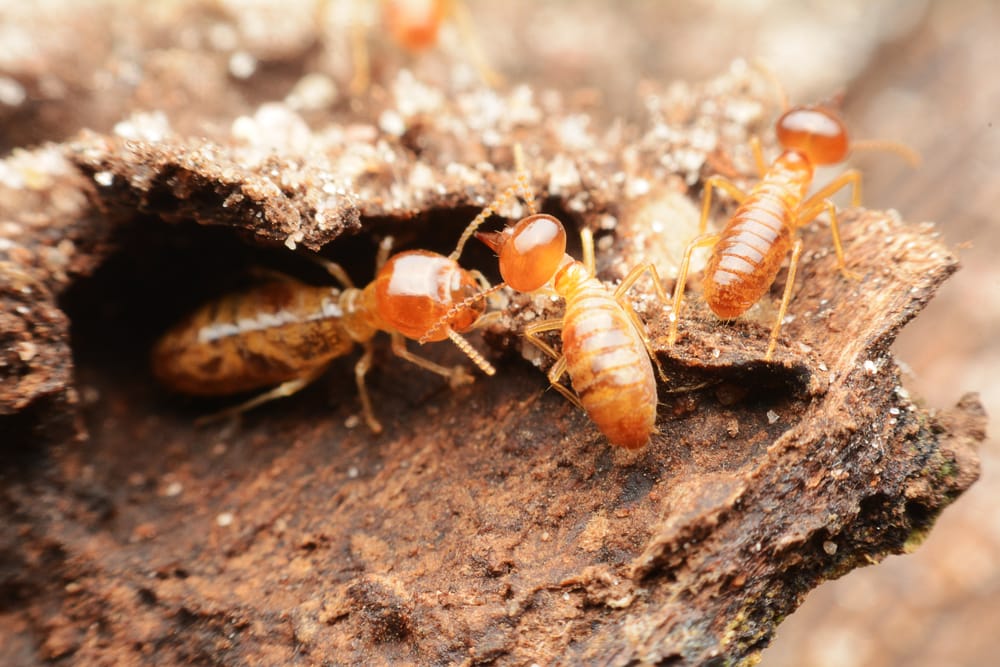Flying Termites
What's on this Page?
Should I worry about flying termites?What causes flying termites in your house?Are flying termites bad?Are flying ants termites?
20 March 2023 · Last updated on 20 March 2023
While an infestation of these insects can cause you a significant amount of grief, the good news is that they don't live very long. These termites are no different than regular termites – they are simply in the reproductive stage of their lifecycle, which allows them to start flying around the place. While this insect may seem similar to winged ants, there are some subtle indications that allow you to identify if you’re looking at a flying termite, listed below.
-
Four equal-sized wings.
-
Straight antennae. These termites are also known as alates or swarmers. The good news is that they aren’t very long-lived – in fact, once they take flight, their lifespan is less than 24 hours. While you can develop an infestation at any point in the year, flying termites are most common following rains and in warmer, spring weather. This makes Australian homes especially vulnerable to these insects, as the country’s climate is perfect for these insects.
Should I worry about flying termites?
Flying termites in and around your home essentially means that a new colony has been created nearby. There is a chance that your house has been infested as well. That said, just because you’ve noticed alates in your home doesn’t mean you should panic. The termites may have flown in from a neighbouring property. If you have an infestation, there’s a risk of significant damage to your home. It’s essential to get in touch with professional pest control services as soon as possible. A professional will be able to let you know whether or not you should be concerned about the flying termites you noticed. If there is an infestation, it will need to be dealt with as soon as possible before it becomes a major issue. Signs that your home may have a termite infestation include:
-
Mud tubes in and around your property. If you damage a tube and find it has been repaired, there’s a good chance you have an active infestation.
-
Structural issues, such as sagging, broken wood fixtures like door jambs, or buckling floors.
-
Termite droppings and broken wings and other remains of dead termites, including flying termites.
What causes flying termites in your house?
Alates indicate that there is a new colony located somewhere in the area. However, even if the colony isn’t in your home, these insects may find their way there. Some reasons that winged termites enter your home include:
Light
Flying termites are attracted to light and may find their way inside your light fittings if possible.
Moisture
Leaky pipes, poor airflow, and bad drainage create a moisture-rich environment in which all types of termites, including winged termites, thrive.
Cracks
If there is a crack in your home’s foundation or a gap in the siding, termites have an opportunity to make their way into your home. Once inside, they can start breeding and setting up new colonies. There are measures you can take to reduce your susceptibility to flying termite invasion. These include:
-
Correcting any moisture issues you may have, including leaks and excess condensation.
-
Checking weather control units to make sure there are no issues that can increase the moisture in your home.
-
Avoid wood to soil contact and remove unnecessary wood around your home and yard, including fallen trees and branches, leaf litter, construction materials, etc.
-
Ensure that there is no accumulation of water in and around your home, including pools of rainwater.
-
Not using untreated wood for construction projects.
Are flying termites bad?
Flying termites are not inherently harmful to humans – they are neither toxic nor disease-carrying, which means you don’t have to worry about falling sick due to an infestation the same way you do with mosquitoes. Some people have suffered asthma attacks due to living in a home infested with flying termites. The major issue that these insects pose to people isn’t health-related and more about the warning signs seeing them in your home poses. Unless you’re able to find a colony, you will likely have to get in touch with a professional to determine the extent (if any) of the flying termite infestation you are facing. If your house has been infested, it’s essential to get it treated as soon as possible. Winged termites indicate a new colony, and without professional help, you risk your house being overtaken by termites.
Are flying ants termites?
While they may look similar at first glance, flying ants and termites are two different types of flying insects. Indications of a flying termite include straight antennae and waists, as well as wings of equal size. On the other hand, flying ants have bent antennae, a pinched waist and wings of unequal length. Aside from differences in appearance, flying ants and alates differ in behaviour as well. While both termites and some types of ants can be found in trees, wood debris and other wooden locations, only termites actually eat the wood and cause structural damage. If ants are present in wood, they only make their home there – they do not eat the wood, nor do they cause structural damage. Instead, they mainly consume nectar, other seeds, food debris, and similar items. If you have flying termites in your home, it’s essential to begin treatment as soon as possible, especially if you see more than a single insect or you see broken wings around your house. A professional will be able to provide you with the best possible guidance over what your next steps should be.








